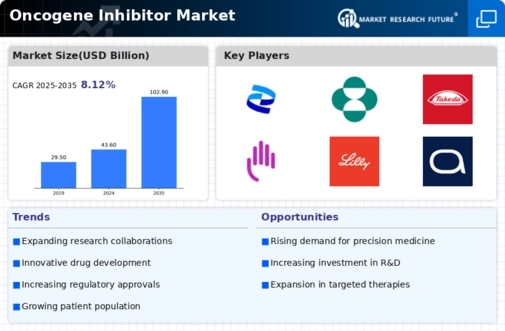Rising Incidence of Cancer
The increasing prevalence of cancer worldwide is a primary driver for the Oncogene Inhibitor Market. According to recent statistics, cancer cases are projected to rise significantly, with estimates suggesting that by 2040, the number of new cancer cases could reach 30 million annually. This alarming trend necessitates the development of targeted therapies, including oncogene inhibitors, which are designed to specifically target genetic mutations associated with various cancers. As healthcare systems strive to address this growing burden, the demand for effective oncogene inhibitors is likely to surge, propelling market growth. Furthermore, the shift towards precision medicine, which tailors treatment based on individual genetic profiles, further emphasizes the need for innovative oncogene inhibitors that can provide personalized treatment options for patients.
Advancements in Genomic Research
The rapid advancements in genomic research are significantly influencing the Oncogene Inhibitor Market. With the advent of next-generation sequencing technologies, researchers are now able to identify specific oncogenes and their mutations with unprecedented accuracy. This has led to the discovery of novel targets for oncogene inhibitors, enhancing the development pipeline for new therapies. Market data indicates that the oncology segment of the pharmaceutical industry is expected to grow at a compound annual growth rate of over 10% through the next decade, driven by these advancements. As more oncogenes are characterized, the potential for developing targeted therapies increases, thereby expanding the oncogene inhibitor market. The integration of genomic data into clinical practice is likely to facilitate the approval and adoption of these innovative therapies, further stimulating market growth.
Growing Demand for Targeted Therapies
The shift towards targeted therapies in cancer treatment is a significant driver for the Oncogene Inhibitor Market. Patients and healthcare providers increasingly prefer treatments that specifically target cancer cells while minimizing damage to healthy tissues. This trend is supported by clinical evidence demonstrating that targeted therapies, including oncogene inhibitors, often result in improved patient outcomes and reduced side effects compared to traditional chemotherapy. Market analysis suggests that the targeted therapy segment is expected to account for a substantial share of the oncology market, with oncogene inhibitors playing a crucial role in this transformation. As more oncogene inhibitors receive regulatory approval and enter the market, the demand for these specialized treatments is likely to grow, reflecting a broader shift in cancer care towards precision medicine.
Increased Funding for Cancer Research
The Oncogene Inhibitor Market is benefiting from increased funding for cancer research initiatives. Governments and private organizations are allocating substantial resources to support innovative research aimed at understanding the genetic basis of cancer. This influx of funding is facilitating the development of new oncogene inhibitors, as researchers are empowered to explore novel therapeutic targets. Recent reports indicate that funding for cancer research has seen a significant uptick, with billions of dollars being invested annually. This financial support not only accelerates the discovery of new oncogene inhibitors but also enhances collaboration between academic institutions and pharmaceutical companies, fostering an environment conducive to innovation. As research progresses, the pipeline for oncogene inhibitors is expected to expand, further driving market growth.
Regulatory Approvals and Fast-Track Designations
The regulatory landscape for oncogene inhibitors is evolving, with agencies increasingly providing fast-track designations and priority reviews for promising therapies. This trend is a crucial driver for the Oncogene Inhibitor Market, as it expedites the approval process for innovative treatments. Regulatory bodies recognize the urgent need for effective cancer therapies, leading to streamlined pathways for oncogene inhibitors that demonstrate significant clinical benefits. Recent data indicates that therapies receiving fast-track designation are more likely to reach the market sooner, thereby enhancing their commercial potential. As more oncogene inhibitors gain regulatory approval, the market is poised for growth, with increased availability of these targeted therapies for patients. This regulatory support not only fosters innovation but also instills confidence in investors and stakeholders within the oncogene inhibitor market.


















Leave a Comment